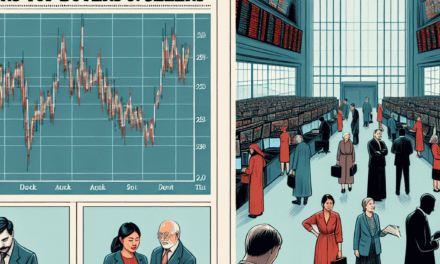“Securing Your Golden Years: Navigating Retirement with a $3.6 Million Equity Cushion”
Introduction
Retiring at the age of 69 with a monthly income of $6,000 and a substantial $3.6 million investment in equities presents a unique financial scenario that requires careful consideration. As retirees transition from active income to relying on their savings and investments, the safety and sustainability of their financial portfolio become paramount. With a significant portion of assets tied up in equities, understanding the risks and potential returns associated with stock market investments is crucial. This situation calls for a strategic approach to managing market volatility, inflation, and the need for a steady income stream to ensure long-term financial security. Evaluating the safety of such a portfolio involves assessing diversification, risk tolerance, and the potential impact of economic fluctuations on equity investments.
Understanding Market Volatility: Protecting Your Retirement Portfolio
As you transition into retirement, the financial landscape can seem both promising and daunting. With a monthly income of $6,000 and a substantial $3.6 million invested in equities, the question of whether your portfolio is secure becomes paramount. Understanding market volatility and its implications on your retirement savings is crucial to ensuring a stable financial future.
Market volatility refers to the fluctuations in the price of securities within the stock market. These fluctuations can be influenced by a myriad of factors, including economic indicators, geopolitical events, and changes in market sentiment. While equities have historically provided higher returns compared to other asset classes, they are also subject to greater volatility. This inherent risk can pose a significant challenge for retirees who rely on their investment portfolio for a steady income.
To protect your retirement portfolio from the adverse effects of market volatility, diversification is a key strategy. By spreading investments across various asset classes, sectors, and geographic regions, you can mitigate the impact of a downturn in any single area. For instance, incorporating bonds, real estate, or commodities into your portfolio can provide a buffer against equity market swings. These asset classes often exhibit different performance patterns, which can help stabilize your overall returns.
Moreover, it is essential to regularly review and rebalance your portfolio. As market conditions change, the allocation of your investments may drift from your original strategy. Rebalancing involves adjusting your holdings to maintain your desired level of risk and return. This process not only helps in managing risk but also ensures that your portfolio remains aligned with your financial goals.
Another important consideration is the sequence of returns risk, which refers to the order in which investment returns occur. For retirees, experiencing negative returns early in retirement can significantly impact the longevity of their portfolio. To mitigate this risk, maintaining a cash reserve or a bond ladder can provide a cushion during periods of market downturns, allowing you to avoid selling equities at a loss to meet your income needs.
Additionally, adopting a dynamic withdrawal strategy can enhance the sustainability of your retirement income. Instead of withdrawing a fixed percentage annually, consider adjusting your withdrawals based on market performance. During years of strong returns, you might increase your withdrawals, while in years of poor performance, reducing withdrawals can help preserve your capital.
Furthermore, staying informed about economic trends and market developments is vital. Engaging with financial advisors or utilizing financial planning tools can provide valuable insights and guidance tailored to your specific situation. These resources can help you make informed decisions and adjust your strategy as needed.
In conclusion, while a $3.6 million equity portfolio offers significant potential for growth, it is not immune to market volatility. By employing strategies such as diversification, regular rebalancing, and dynamic withdrawal planning, you can better protect your retirement savings. Understanding the nuances of market behavior and proactively managing your investments will help ensure that your financial future remains secure, allowing you to enjoy your retirement with peace of mind.
Diversification Strategies for Retirees: Beyond Equities
As retirees transition into a new phase of life, financial security becomes a paramount concern. For those like the individual retired at 69 with a $6,000 monthly income and $3.6 million invested in equities, the question of whether their portfolio is safe is both pressing and complex. While equities have historically provided substantial returns, they also come with inherent risks, particularly for retirees who may not have the luxury of time to recover from market downturns. Therefore, diversification strategies become essential to ensure a stable and secure financial future.
To begin with, diversification is a fundamental principle in investment that involves spreading investments across various asset classes to reduce risk. For retirees heavily invested in equities, this means considering other asset classes such as bonds, real estate, and commodities. Bonds, for instance, are often seen as a safer investment compared to equities. They provide regular interest payments and can act as a buffer against the volatility of the stock market. By allocating a portion of the portfolio to bonds, retirees can achieve a more balanced risk profile, ensuring that their income needs are met even during market downturns.
Moreover, real estate can serve as another viable diversification strategy. Investing in real estate, whether through direct property ownership or real estate investment trusts (REITs), can provide a steady income stream and potential for capital appreciation. Real estate often behaves differently from stocks and bonds, offering a hedge against inflation and market volatility. This can be particularly beneficial for retirees seeking to preserve their wealth while generating income.
In addition to bonds and real estate, commodities such as gold and silver can also play a role in a diversified portfolio. These tangible assets often retain value during economic uncertainty and can act as a safeguard against inflation. While commodities do not provide income in the form of dividends or interest, their inclusion in a portfolio can enhance overall stability and reduce risk.
Furthermore, retirees should consider the role of cash and cash equivalents in their diversification strategy. Maintaining a portion of the portfolio in cash or money market funds provides liquidity and flexibility, allowing retirees to meet short-term expenses without having to sell other investments at an inopportune time. This liquidity can be crucial during periods of market volatility, ensuring that retirees can maintain their lifestyle without compromising their long-term financial goals.
Additionally, it is important for retirees to regularly review and adjust their diversification strategy. As market conditions and personal circumstances change, so too should the composition of their investment portfolio. Consulting with a financial advisor can provide valuable insights and help retirees make informed decisions that align with their risk tolerance and income needs.
In conclusion, while a $3.6 million equity portfolio may seem substantial, relying solely on equities can expose retirees to unnecessary risk. By embracing diversification strategies that include bonds, real estate, commodities, and cash, retirees can enhance the safety and stability of their financial future. This balanced approach not only mitigates risk but also ensures that retirees can enjoy their golden years with peace of mind, knowing that their financial well-being is secure.
Inflation and Its Impact on Retirement Savings
As retirees navigate the complexities of financial planning, the question of whether their savings will withstand the test of time becomes increasingly pertinent. For those who have accumulated substantial wealth, such as a $3.6 million portfolio in equities, the concern often shifts to the impact of inflation on their retirement savings. Inflation, the gradual increase in prices over time, can erode purchasing power, making it a critical factor to consider when evaluating the safety and longevity of one’s retirement funds.
To understand the implications of inflation on a retirement portfolio, it is essential to first recognize how inflation affects the cost of living. As prices rise, the same amount of money buys fewer goods and services. For retirees relying on a fixed income, such as a $6,000 monthly withdrawal, inflation can significantly diminish their standard of living over time. This is particularly concerning for those with a long retirement horizon, as even modest inflation rates can compound and lead to substantial increases in living expenses.
Equities, or stocks, are often considered a hedge against inflation due to their potential for growth. Historically, equities have outpaced inflation, providing returns that exceed the rate at which prices rise. This growth potential makes equities an attractive option for retirees seeking to preserve their purchasing power. However, equities also come with inherent risks, including market volatility and the potential for significant losses. Therefore, while equities can offer protection against inflation, they also require careful management and a well-diversified portfolio to mitigate risks.
Diversification is a key strategy in managing the impact of inflation on retirement savings. By spreading investments across various asset classes, retirees can reduce their exposure to market fluctuations and enhance the stability of their portfolio. In addition to equities, incorporating fixed-income securities, such as bonds, can provide a steady income stream and act as a buffer against market downturns. Moreover, including assets that traditionally perform well during inflationary periods, such as real estate or commodities, can further safeguard against the erosion of purchasing power.
Another important consideration is the withdrawal strategy employed during retirement. A sustainable withdrawal rate is crucial to ensuring that savings last throughout retirement, even in the face of inflation. The commonly referenced 4% rule suggests that retirees can withdraw 4% of their portfolio annually, adjusted for inflation, without depleting their savings. However, this rule may not be suitable for everyone, particularly in periods of high inflation or market instability. Retirees should regularly reassess their withdrawal strategy, taking into account current economic conditions and their personal financial situation.
In conclusion, while a $3.6 million equity portfolio provides a strong foundation for retirement, it is not immune to the effects of inflation. Retirees must remain vigilant in managing their investments, ensuring diversification and adopting a flexible withdrawal strategy to protect their purchasing power. By understanding the relationship between inflation and retirement savings, and by implementing prudent financial strategies, retirees can enhance the safety and longevity of their portfolio, ultimately securing a more stable and comfortable retirement.
The Role of Bonds in a Retirement Portfolio

As individuals approach retirement, the composition of their investment portfolio becomes a critical consideration. For someone retired at 69 with a monthly income of $6,000 and a substantial $3.6 million invested in equities, the question of safety and stability is paramount. While equities have historically offered robust returns, they are also subject to market volatility, which can pose significant risks to a retiree’s financial security. This is where bonds come into play, serving as a stabilizing force within a retirement portfolio.
Bonds, often considered the bedrock of conservative investment strategies, provide a predictable income stream and help mitigate the risks associated with equities. They are essentially loans made by an investor to a borrower, typically a corporation or government, which pays back the principal along with interest over a specified period. This fixed-income component can be particularly appealing to retirees who prioritize income stability over growth. By incorporating bonds into a portfolio, retirees can achieve a more balanced asset allocation, reducing the overall volatility and potential for significant losses during market downturns.
Moreover, bonds offer diversification benefits that are crucial for a retiree heavily invested in equities. Diversification is a fundamental principle of investing, aimed at spreading risk across various asset classes. By holding a mix of stocks and bonds, retirees can protect their portfolios from the full brunt of equity market fluctuations. For instance, when stock markets experience a downturn, bonds often perform better or remain stable, thereby cushioning the impact on the overall portfolio. This inverse relationship between stocks and bonds can be particularly advantageous during periods of economic uncertainty.
In addition to providing stability and diversification, bonds can also serve as a source of liquidity. Retirees may need to access funds for unexpected expenses or to supplement their income during periods of market volatility. Bonds, especially those with shorter maturities, can be sold relatively easily without incurring significant losses, providing retirees with the flexibility to manage their cash flow needs effectively. This liquidity aspect is essential for maintaining financial independence and peace of mind during retirement.
However, it is important to recognize that not all bonds are created equal. The bond market is diverse, encompassing government bonds, corporate bonds, municipal bonds, and more, each with varying levels of risk and return. Government bonds, such as U.S. Treasuries, are generally considered the safest, backed by the full faith and credit of the issuing government. On the other hand, corporate bonds may offer higher yields but come with increased risk, particularly if issued by companies with lower credit ratings. Therefore, retirees must carefully assess their risk tolerance and investment objectives when selecting bonds for their portfolio.
In conclusion, while a $3.6 million equity portfolio can provide substantial growth potential, the inclusion of bonds is essential for ensuring stability and security in retirement. Bonds offer a reliable income stream, diversification benefits, and liquidity, all of which are crucial for managing the financial challenges that may arise during retirement. By thoughtfully integrating bonds into their investment strategy, retirees can enhance the resilience of their portfolios, safeguarding their financial well-being and allowing them to enjoy their retirement years with confidence.
Safe Withdrawal Rates: Ensuring Longevity of Your Savings
Retirement planning is a multifaceted endeavor that requires careful consideration of various financial elements to ensure a stable and secure future. For individuals like the retiree in question, who has accumulated $3.6 million in equities and enjoys a monthly income of $6,000, the focus often shifts to the sustainability of their savings. A critical aspect of this is understanding safe withdrawal rates, which are essential in ensuring that one’s savings last throughout retirement.
The concept of a safe withdrawal rate is rooted in the need to balance withdrawals with the longevity of one’s investment portfolio. Traditionally, the 4% rule has been a popular guideline, suggesting that retirees can withdraw 4% of their initial retirement portfolio annually, adjusted for inflation, without depleting their savings over a 30-year period. However, this rule is not without its critics, as it does not account for varying market conditions, inflation rates, or individual circumstances. Therefore, retirees must consider a more personalized approach to withdrawal rates.
In the case of a retiree with $3.6 million in equities, the primary concern is the volatility associated with equity investments. Equities, while historically offering higher returns than other asset classes, are subject to market fluctuations that can impact the value of the portfolio. To mitigate this risk, diversification is key. By spreading investments across different sectors, geographical regions, and asset classes, retirees can reduce the impact of market volatility on their overall portfolio. Additionally, incorporating fixed-income securities, such as bonds, can provide a more stable income stream and act as a buffer against equity market downturns.
Moreover, it is crucial to regularly reassess one’s withdrawal strategy in light of changing market conditions and personal circumstances. This involves monitoring the performance of the investment portfolio and making adjustments as necessary. For instance, during periods of strong market performance, retirees might consider withdrawing a smaller percentage of their portfolio to preserve capital for future downturns. Conversely, in times of market decline, it may be prudent to reduce withdrawals or rely on cash reserves to avoid selling equities at a loss.
Another important consideration is the impact of inflation on purchasing power. Inflation erodes the value of money over time, which can significantly affect a retiree’s ability to maintain their standard of living. To combat this, retirees should ensure that their investment portfolio includes assets that have the potential to outpace inflation, such as equities and real estate. Additionally, maintaining a portion of the portfolio in inflation-protected securities, like Treasury Inflation-Protected Securities (TIPS), can provide a hedge against rising prices.
Furthermore, retirees should be mindful of tax implications associated with withdrawals. Different types of accounts, such as traditional IRAs, Roth IRAs, and taxable accounts, have varying tax treatments. Strategic withdrawal planning can help minimize tax liabilities and maximize the longevity of retirement savings. Consulting with a financial advisor or tax professional can provide valuable insights into optimizing withdrawal strategies.
In conclusion, ensuring the longevity of retirement savings requires a comprehensive understanding of safe withdrawal rates and a proactive approach to managing one’s investment portfolio. By diversifying investments, regularly reassessing withdrawal strategies, accounting for inflation, and considering tax implications, retirees can enhance the sustainability of their savings. For those with substantial equity holdings, like the retiree with $3.6 million, these strategies are particularly pertinent in navigating the complexities of retirement planning and securing a financially stable future.
The Importance of Regular Portfolio Reviews in Retirement
As individuals transition into retirement, the financial landscape shifts dramatically, necessitating a reassessment of investment strategies to ensure long-term stability and security. For someone retired at 69 with a monthly income of $6,000 and a substantial $3.6 million invested in equities, the question of whether this portfolio is safe becomes paramount. The importance of regular portfolio reviews in retirement cannot be overstated, as they serve as a critical tool in safeguarding one’s financial future.
To begin with, the volatility inherent in equity markets poses a significant risk to retirees who rely on their investments for income. While equities have historically provided higher returns compared to other asset classes, they are also subject to market fluctuations that can erode the value of a portfolio. Therefore, conducting regular reviews allows retirees to assess their risk exposure and make necessary adjustments. By evaluating the performance of individual stocks and the overall market conditions, retirees can determine if their current asset allocation aligns with their risk tolerance and financial goals.
Moreover, as retirees age, their financial needs and priorities may evolve, necessitating a shift in investment strategy. For instance, a retiree may initially prioritize growth to ensure their portfolio keeps pace with inflation. However, as they progress further into retirement, the focus may shift towards preserving capital and generating a steady income stream. Regular portfolio reviews facilitate this transition by providing an opportunity to rebalance the portfolio, potentially incorporating more conservative investments such as bonds or dividend-paying stocks to reduce risk and enhance income stability.
In addition to adjusting for risk and changing financial needs, regular portfolio reviews also help retirees stay informed about external factors that could impact their investments. Economic conditions, interest rates, and geopolitical events can all influence market performance and, consequently, the value of a retiree’s portfolio. By staying abreast of these developments, retirees can make informed decisions about whether to hold, sell, or buy certain assets. This proactive approach not only helps mitigate potential losses but also positions retirees to capitalize on new opportunities that may arise.
Furthermore, regular reviews provide an opportunity to evaluate the performance of financial advisors or investment managers, if applicable. Retirees who entrust their portfolios to professionals should ensure that their advisors are acting in their best interests and delivering satisfactory results. By reviewing performance metrics and comparing them against benchmarks, retirees can assess whether their advisors are meeting expectations and make changes if necessary.
Finally, it is essential to recognize that regular portfolio reviews are not solely about making changes. They also serve as a reassurance mechanism, confirming that the current strategy remains sound and aligned with long-term objectives. This peace of mind is invaluable for retirees, allowing them to enjoy their retirement years without the constant worry of financial instability.
In conclusion, for a retiree with a $3.6 million equity portfolio and a $6,000 monthly income, regular portfolio reviews are crucial in ensuring the safety and sustainability of their investments. By addressing risk exposure, adapting to changing needs, staying informed about external factors, evaluating advisor performance, and providing reassurance, these reviews play a vital role in maintaining financial security throughout retirement. As such, retirees should prioritize this practice, viewing it as an integral component of their overall financial strategy.
Navigating Economic Downturns: Lessons for Retirees
Retirement is a significant milestone, often accompanied by a mix of excitement and apprehension. For those who have diligently saved and invested, reaching this stage with a substantial nest egg is a testament to years of careful planning and discipline. However, even with a robust portfolio, such as $3.6 million in equities, retirees must remain vigilant, particularly in the face of economic downturns. The question of whether this sum is safe becomes paramount, especially when relying on a $6,000 monthly income to sustain one’s lifestyle.
To begin with, understanding the nature of equities is crucial. Equities, or stocks, represent ownership in a company and are known for their potential to deliver high returns over the long term. However, they are also subject to market volatility, which can be unsettling for retirees who depend on their investments for regular income. During economic downturns, stock prices can fluctuate significantly, potentially eroding the value of one’s portfolio. Therefore, it is essential for retirees to adopt strategies that mitigate risk while ensuring a steady income stream.
One effective approach is diversification. By spreading investments across various sectors and asset classes, retirees can reduce the impact of a downturn in any single area. This strategy not only helps in preserving capital but also provides opportunities for growth in different market conditions. Additionally, incorporating fixed-income securities, such as bonds, into the portfolio can offer stability and generate regular interest payments, which can supplement monthly income needs.
Moreover, maintaining a cash reserve is another prudent measure. Having a buffer of liquid assets allows retirees to cover living expenses without having to sell equities during a market dip. This reserve acts as a financial cushion, providing peace of mind and reducing the pressure to liquidate investments at an inopportune time. Typically, a reserve covering six months to two years of expenses is advisable, depending on individual circumstances and risk tolerance.
Furthermore, retirees should consider the sequence of returns risk, which refers to the potential negative impact of withdrawing funds during a market downturn. This risk can significantly affect the longevity of a retirement portfolio. To counteract this, retirees might employ a dynamic withdrawal strategy, adjusting the amount taken from their portfolio based on market performance. For instance, withdrawing less during a downturn and more during prosperous times can help preserve the portfolio’s value over the long term.
In addition to these financial strategies, staying informed about economic trends and market conditions is vital. Regularly reviewing and, if necessary, rebalancing the portfolio ensures that it aligns with one’s risk tolerance and financial goals. Consulting with a financial advisor can provide valuable insights and help retirees navigate complex market environments.
In conclusion, while a $3.6 million equity portfolio provides a strong foundation for retirement, it is not immune to the challenges posed by economic downturns. By employing strategies such as diversification, maintaining a cash reserve, and being mindful of withdrawal rates, retirees can enhance the safety of their investments and secure their financial future. Ultimately, the key lies in balancing risk and reward, allowing retirees to enjoy their golden years with confidence and peace of mind.
Q&A
1. **Question:** What is the primary concern for someone retired at 69 with $6,000 monthly income and $3.6 million in equities?
– **Answer:** The primary concern is whether their $3.6 million in equities is safe and can sustain their retirement needs.
2. **Question:** What factors should be considered to determine the safety of $3.6 million in equities?
– **Answer:** Factors include market volatility, diversification of the investment portfolio, withdrawal rate, inflation, and potential healthcare costs.
3. **Question:** How can diversification help in ensuring the safety of the $3.6 million in equities?
– **Answer:** Diversification can reduce risk by spreading investments across various asset classes, sectors, and geographic regions, minimizing the impact of a downturn in any single area.
4. **Question:** What is a safe withdrawal rate for someone with $3.6 million in equities?
– **Answer:** A commonly recommended safe withdrawal rate is around 4% annually, which would equate to $144,000 per year or $12,000 per month, allowing for adjustments based on individual circumstances.
5. **Question:** How does inflation impact the safety of a $3.6 million equity portfolio?
– **Answer:** Inflation erodes purchasing power over time, so the portfolio must generate returns that outpace inflation to maintain the retiree’s standard of living.
6. **Question:** What role do healthcare costs play in assessing the safety of the $3.6 million in equities?
– **Answer:** Healthcare costs can be significant and unpredictable in retirement, so it’s important to have a plan to cover these expenses without depleting the investment portfolio too quickly.
7. **Question:** What strategies can be employed to protect the $3.6 million in equities during market downturns?
– **Answer:** Strategies include maintaining a diversified portfolio, having a cash reserve to avoid selling equities at a loss, and possibly using hedging techniques or reallocating to more conservative investments during volatile periods.
Conclusion
With a $6,000 monthly income requirement and a $3.6 million equity portfolio, the individual is in a strong financial position. Assuming a conservative withdrawal rate of around 2% annually, the portfolio should comfortably support the income needs while allowing for growth and inflation adjustments. However, market volatility and economic conditions can impact equity values, so diversification and regular portfolio reviews are essential to mitigate risks and ensure long-term financial security. Consulting with a financial advisor for personalized strategies would be prudent.





